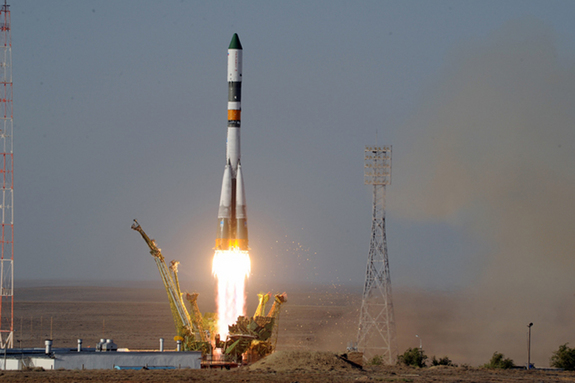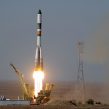
US Restrictions Hurt Russian Space Defense and Commercial Projects
Publication: Eurasia Daily Monitor Volume: 11 Issue: 91
By:

In response to Russia’s involvement in the Ukrainian crisis, the United States has tightened its export controls, and this has seriously hurt important Russian space projects. US authorities are apparently denying export licenses that allow European and other foreign communications satellites containing US components to be launched into space by Russian rockets. This decision has effectively pushed the Russian Federation out of the highly prestigious (though limited) international space launch market. In 2014, the country’s space agency, Roscosmos, was planning 38 space launches, with 10 of them contracted to carry foreign payloads. Commercial space launches of foreign satellites have been bringing Russia some $700–800 million a year. This additional income is important both economically and psychologically—a symbolic vestige of Russia still being a high-tech powerhouse. If Russia is pushed out of the commercial satellite launch marketplace by US sanctions, even temporarily, it would be difficult to ever come back fully, as cheaper Chinese and private US space launchers pick up its market share (https://expert.ru/2014/04/29/podstavili-soyuznikov/).
The Russian space industry has, in recent years, been using US-made and designed materials and radiation-resistant electronics to produce double-use and military satellites. Procuring these components may become a problem that could significantly hinder efforts to rebuild Russia’s military and intelligence-gathering space programs. Deputy Prime Minister Dmitry Rogozin, in charge of Russia’s space and defense industries, complained: “The US is not only limiting its cooperation with Russia, it is putting pressure on other nations to forbid the shipment of satellites built for Russia in Western Europe, if they contain American components” (https://www.rg.ru/2014/05/13/bumerang-site.html).
New Russian communications satellites of the “Express” series are built by a subsidiary of the European Aeronautic Defense and Space Company (EADS—hence reorganized as Airbus Group) (Kommersant, November 11, 2013). The French-Italian Thales Alenia Space company has been helping build a second geodesy satellite Geo-IK-2, providing key components that will help build a precise, three-dimensional map of the Earth’s surface. The first Geo-IK-2, also known as Kosmos 2470, was launched in 2011 into a wrong orbit because of rocket failure and eventually crashed. The second Geo-IK-2 is reported to have been substantially modernized using space-quality electronic components and is scheduled to be launched this year. The Russian press has described the Geo-IK-2 as a “military satellite,” and the high-resolution 3D world map it is designed to produce (surpassing existing Russian versions) could be used for precision weapons targeting and improving the effectiveness of satellite intelligence gathering (https://www.interfax.ru/russia/318110). Roscosmos hopes to eventually have two Geo-IK-2 satellites permanently in orbit. The loss of the first was a serious calamity, while now US sanctions threaten to cancel the entire project.
Before the Ukrainian crisis, during the heyday of President’s Barack Obama’s “reset” charm offensive, Washington was apparently turning a blind eye to aggressive Russian procurement of high-tech, double-use equipment and technologies. Today a US move to deny high-tech export licenses threatens to set back the entire Russian military modernization project, which is based primarily on using space-connected technologies to develop new precision weapons, intelligence-gathering, communications, and command and control capabilities. In response Rogozin went ballistic, threatening to terminate US-Russian space cooperation programs: to stop selling RD-180 and NK-33 rocket engines “if they are used to launch US military satellites,” to close down GPS correction (Global Navigation Satellite System—GNSS) stations on Russian soil, and sink prematurely in the ocean the International Space Station (ISS) by 2020 (https://www.rg.ru/2014/05/13/bumerang-site.htm).
Russia has been selling to the US rocket engines that are attached to space boosters like the Atlas, produced jointly by Boeing and Lockheed Martin. The Atlas rocket is used to launch military US satellites; so it seems, under Rogozin’s terms, the export of RD-180 engines it uses will be terminated and the Atlas may be phased out of use. But Russia has already shipped to the United States a sizable supply of RD-180s—enough to last two years, while alternative US-made engines or privately produced launchers are being introduced (https://www.vedomosti.ru/tech/news/26468181/zapret-na-postavku-rossijskih-raketnyh-dvigatelej-poka-ne#ixzz31j4nAK9B). Russia’s contract to sell the US 101 RD-180 rocket engines worth hundreds of millions of dollars may be lost (https://www.interfax.ru/world/376022).
There are 150 International GNSS Service (IGS) stations worldwide, and 11 of them are in Russia run by Russian scientists. The IGS is a worldwide US-sponsored network that also functions as a global seismic monitoring service, and all participants share information. Rogozin has been demanding, since last November, the IGS equipment be switched off to put pressure on the US, but Russian scientists say they will lose more if removed from the IGS network, while the quality of the GPS signal will not be affected much at all (https://izvestia.ru/news/570736).
Russia has previously tentatively agreed to continue to jointly run the ISS until 2024, but now Rogozin insists this is senseless and the space station must be terminated by 2020. He suggested that the money saved be diverted to more ambitious programs, like creating a permanent Russian base on the Moon to mine and claim it as Russian territory by 2030, before other nations form a substantial presence there (https://izvestia.ru/news/570482). The National Aeronautics and Space Administration (NASA), at present, pays Roscosmos some $60 million for a single astronaut return trip to and from the International Space Station until 2017, when private US space companies hope to be ready to provide NASA with passenger-carrying spaceships. The ISS cannot function without close US-Russian cooperation: The American ISS section provides the Russian modules with electrical power and so on. The Russians have mostly built a new 20-ton additional block for the ISS, planned to be launched in 2017. A premature termination of the space station in 2020 would nullify this and other costly Russian investments into the ISS (https://www.newsru.com/arch/world/14may2014/space.html).
This week in Sochi, President Vladimir Putin announced: “We must ensure that everything our defense industry needs and uses is produced on our territory and we do not depend on anyone” (https://www.kremlin.ru/news/21021). Russian experts consider Putin’s call for complete scientific and technological self-sufficiency to be an impossible task (https://top.rbc.ru/politics/14/05/2014/923813.shtml). Russia’s Trade and Industry Minister Denis Manturov told journalists that he was surprised by calls to undermine the work of GPS-connected equipment in Russia. He did not see any sense in such obstruction and wondered if “Rogozin was just promoting his personal opinion” (https://www.interfax.ru/print.asp?sec=1448&id=376041). Manturov was immediately rebuked: A government spokesperson confirmed all announced anti-American moves were officially approved, while Rogozin demanded Manturov “end being part of the fifth column” (https://www.interfax.ru/russia/376039). Rogozin’s anti-American sanctions may hinder Russia more than the US, but they follow Putin’s general line to isolate Russia from the West as much as possible.




